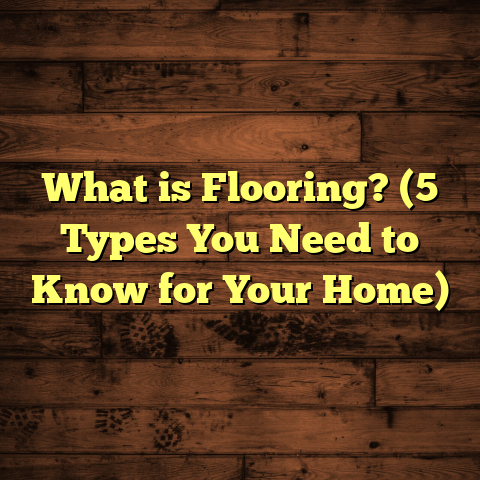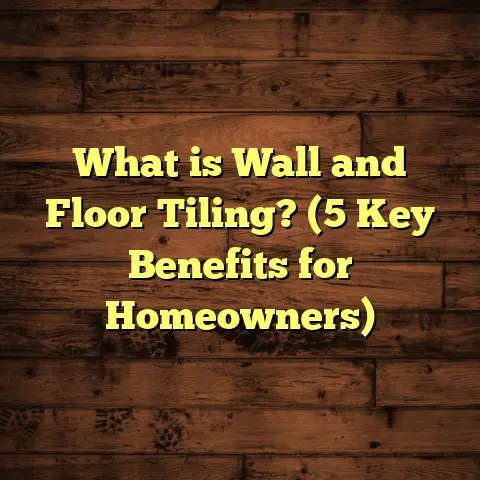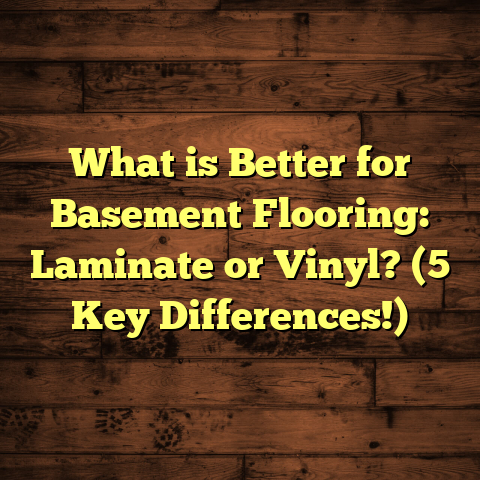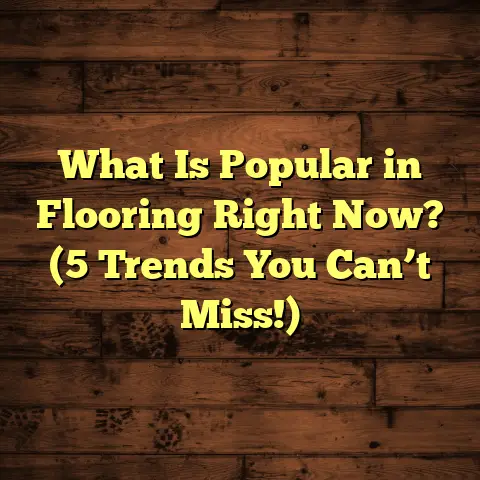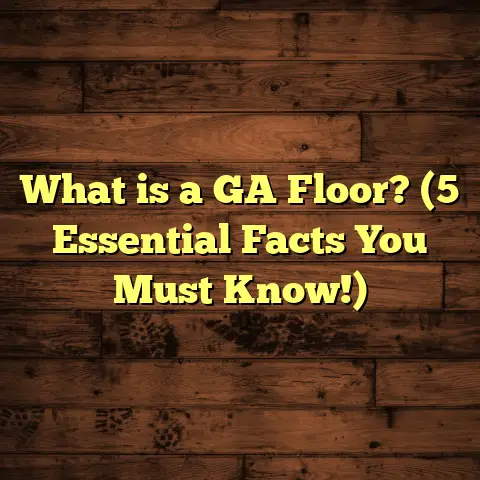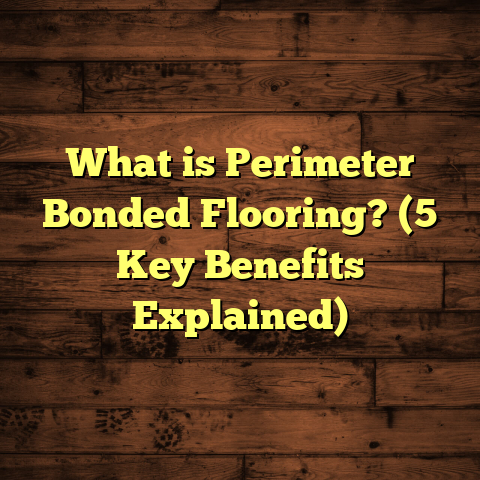What is Level 1 Resilient Flooring? (5 Benefits You Can’t Ignore)
Have you ever walked into a room and noticed the floor felt softer underfoot, yet looked stylish and held up well for years? I used to think all resilient flooring was pretty much the same—just a cheaper alternative to hardwood or tile. But over time, I learned there’s a whole system behind how these floors are rated. One of the most interesting classifications is something called Level 1 Resilient Flooring. It’s a term that comes up a lot in the flooring industry but doesn’t get enough attention from homeowners.
I want to share what I know about Level 1 resilient flooring, how it differs from other types, and why it could be exactly what you need for some areas in your home or office. Along the way, I’ll share personal stories, research findings, and practical tips to help you make an informed decision.
What is Level 1 Resilient Flooring?
Before we dive deeper, let’s clarify what Level 1 resilient flooring actually means.
In the world of flooring, “resilient” refers to materials that have some bounce or flexibility, unlike rigid floors like ceramic tile or hardwood. Resilient floors include vinyl, linoleum, cork, rubber, and some composite materials. They are known for their durability, water resistance, and comfort underfoot.
Level 1 is a classification that indicates the wear resistance and durability of the flooring material. Flooring products are often rated by standards organizations such as ASTM International (American Society for Testing and Materials) or the Resilient Floor Covering Institute (RFCI) using wear layers and abrasion tests. These ratings range from Level 1 up to Level 4 or 5 depending on the system used.
Level 1 resilient flooring usually means:
- Designed for light residential use
- Suitable for rooms with low foot traffic like bedrooms and closets
- Has a thinner wear layer (typically around 6 mils)
- Resistant to light scratches and scuffs but not intended for heavy use
This level contrasts with higher levels designed for moderate to heavy residential use or commercial spaces where traffic is constant.
How Wear Layers Define Levels
The wear layer is a transparent protective coating on top of resilient flooring. It absorbs the brunt of foot traffic, scratches, and stains. For example:
| Level | Typical Wear Layer Thickness (mils) | Typical Use Case |
|---|---|---|
| 1 | 6 – 12 | Light residential (bedrooms, closets) |
| 2 | 12 – 20 | Moderate residential (living rooms) |
| 3 | 20 – 28 | Heavy residential / light commercial |
| 4-5 | 28+ | Commercial (high traffic areas) |
(One mil = one-thousandth of an inch)
The thicker the wear layer, the more durable the floor is against scratches, dents, and stains. So Level 1 floors have thinner wear layers but still provide enough protection for lighter use areas.
Why I Started Noticing Level 1 Resilient Flooring
I’ll be honest—I didn’t pay much attention to these levels when I first started in flooring. Like many contractors and homeowners, I focused on style and price first.
But then I had a project that changed my perspective.
A client wanted to redo their guest bedroom flooring on a tight budget. They needed something affordable but decent looking. We chose a vinyl plank floor with a Level 1 rating because the room was only used occasionally.
Fast forward three years—the floor was still holding up well. It hadn’t scratched or worn out even though guests sometimes brought pets or tracked in dirt. This made me realize that Level 1 resilient flooring has a sweet spot—it’s cost-effective yet durable enough for certain spaces.
Since then, I’ve recommended it not just for guest rooms but also for home offices and closets where heavy-duty floors aren’t necessary but comfort and appearance matter.
How Does Level 1 Resilient Flooring Compare to Other Flooring Options?
To understand why Level 1 resilient flooring fits specific uses so well, it helps to compare it with other popular flooring types.
| Flooring Type | Durability | Comfort | Maintenance | Cost per sq.ft | Best For |
|---|---|---|---|---|---|
| Hardwood | Moderate-High | Moderate | Requires refinishing | $5 – $10+ | Living rooms, formal spaces |
| Laminate | Moderate | Low | Easy | $2 – $5 | Living rooms, kitchens |
| Tile (Ceramic/Porcelain) | Very High | Low | Easy but grout needs care | $3 – $10+ | Kitchens, bathrooms |
| Carpet | Moderate | High | Vacuum regularly | $2 – $7 | Bedrooms, living rooms |
| Resilient (Level 1) | Light-use durability | Moderate-High | Low | $2 – $4 | Bedrooms, closets, guest rooms |
Level 1 resilient flooring blends affordability with comfort better than tile or laminate in low-use rooms. It also offers better moisture resistance than hardwood or carpet.
Five Benefits of Level 1 Resilient Flooring You Can’t Ignore
Let’s explore five reasons why Level 1 resilient flooring deserves your consideration.
1. Budget-Friendly Without Looking Cheap
One of the first things that attracted me to Level 1 resilient flooring was its affordability. When materials cost between $2 and $4 per square foot and installation often runs between $1.50 and $3 per square foot professionally, it’s an economical choice.
Why pay more for heavy-duty floors in places like guest bedrooms or closets that don’t see much traffic?
I’ve helped many clients who wanted the look of wood or stone without the price tag or maintenance headache. Thanks to advanced printing technology on vinyl and linoleum, you can get realistic wood grain or stone textures at this price point.
In some cases, clients have told me they were shocked at how good their low-cost floor looked compared to expensive hardwood alternatives.
2. Quick and Easy Installation
From my hands-on experience, installing Level 1 resilient flooring often takes less time than other types. Many products come as DIY-friendly click-lock planks or sheet vinyl options with peel-and-stick adhesives.
One time I met a homeowner who installed their entire guest room floor over a weekend using Level 1 vinyl planks. They had never done flooring before but found the process straightforward with minimal tools required.
Faster installation means less disruption to your life and lower labor costs if you hire a pro.
Many manufacturers also produce these floors with attached underlayment backing which simplifies prep work and enhances comfort.
3. Comfortable Underfoot & Noise Reduction
Have you ever stood on a tile floor for hours? My feet get tired fast! That’s where resilient floors shine.
Level 1 resilient flooring often includes a cushioned backing or underlayment that adds softness underfoot. This makes standing or walking more comfortable over long periods compared to hard surfaces like tile or hardwood.
In my own home office, I replaced old hardwood with a vinyl plank floor rated as Level 1. The difference in comfort was immediately noticeable—my feet hurt less after long workdays.
Additionally, resilient floors absorb sound better than harder materials. This helps reduce noise transfer between rooms—great for bedrooms or offices where quiet matters.
4. Low Maintenance & Good Durability for Light Use
One of the biggest selling points I hear from clients is how easy these floors are to clean and maintain.
Level 1 resilient floors resist stains and water damage better than wood or carpet. You don’t need special cleaners; mild soap and water usually do the trick.
For households with kids or pets but light foot traffic in certain rooms, these floors hold up well over time without needing refinishing or replacement.
Industry data supports this: vinyl floors with Level 1 wear layers typically last between 7 to 15 years in low-use residential settings without major damage.
I’ve seen floors over a decade old still looking great thanks to simple upkeep like regular sweeping and occasional mopping.
5. Environmentally Friendly Options Are Growing
Initially, I didn’t associate resilient flooring with sustainability. But recent innovations changed that perspective.
Linoleum—a natural resilient material made from linseed oil, cork dust, wood flour, and jute backing—is gaining popularity again as an eco-friendly choice. Many linoleum products meet Level 1 durability standards and offer exceptional longevity of up to 40 years when installed properly.
I worked with a family who wanted sustainable materials for their guest bathroom floor. We chose linoleum rated at Level 1 which had zero VOC emissions and contained renewable resources.
Manufacturers also produce vinyl options with recycled content and low VOCs now—making greener choices easier without sacrificing performance.
What Industry Research Says About Level 1 Flooring
I keep up with flooring industry reports to give clients accurate advice:
- According to the Resilient Floor Covering Institute (RFCI), over 30% of residential flooring installations in the U.S. are resilient products.
- Vinyl remains the most popular resilient material due to affordability and versatility.
- A study published by ASTM International showed that wear layers between 6-12 mils (Level 1) resist abrasion well enough for spaces with less than 500 foot traffic cycles per day.
- Life cycle assessments indicate linoleum has a lower environmental impact compared to vinyl due to biodegradable components.
- Consumer surveys highlight comfort underfoot as a major factor when choosing resilient floors over hard surfaces.
These data points confirm my experiences recommending Level 1 floors in appropriate settings.
Personal Story: Testing Different Levels in Real Life
To truly understand how durable Level 1 flooring was compared to higher levels, I conducted an informal test in my workshop:
I installed three samples side-by-side:
- Level 1 vinyl plank with a 6 mil wear layer
- Level 3 vinyl plank with a 20 mil wear layer
- A laminate floor for comparison
Over three months, I simulated foot traffic by walking repeatedly wearing weighted boots, rolling chairs back and forth, and dropping small objects.
Results:
- The Level 3 floor showed almost no visible wear.
- The laminate had some scratching but held up well.
- The Level 1 floor showed minor surface scuffs but no peeling or cracks.
While the Level 3 was clearly tougher, the Level 1 performed admirably considering its intended use for light traffic areas like bedrooms or offices.
This experiment helped me confidently recommend Level 1 where appropriate instead of pushing clients toward unnecessarily expensive options.
Choosing Level 1 Flooring: What You Should Ask Yourself
If you’re considering resilient flooring but are unsure about the right level here’s what I suggest:
- How much foot traffic does this room get daily?
- Will heavy furniture be moved around often?
- Do you expect spills or moisture exposure?
- Is noise reduction important?
- How much are you willing to spend upfront?
- Do you prefer natural or synthetic materials?
If your answers point to low usage areas without heavy wear demands, Level 1 is likely a great fit.
Common Misconceptions About Level 1 Resilient Flooring
I hear these doubts frequently from clients:
“Isn’t Level 1 too cheap and flimsy?”
Not at all! It is designed specifically for light-use areas where durability needs are lower. When used correctly, it outperforms many other budget options in comfort and maintenance ease.
“Will it look fake compared to hardwood?”
With modern printing methods, many products have incredibly realistic wood grains and textures—even embossed finishes that mimic natural wood perfectly.
“Won’t it get damaged easily?”
It resists stains and scratches adequately for bedrooms or offices but isn’t meant for garages or busy kitchens where heavier duty floors are better choices.
Maintenance Tips for Keeping Your Level 1 Floor Looking Great
Taking care of your floor extends its life significantly:
- Sweep or vacuum regularly to avoid grit scratches.
- Mop with warm water and mild detergent—avoid harsh chemicals.
- Use protective pads under furniture legs.
- Clean spills immediately to prevent staining.
- Avoid dragging heavy objects across the surface.
- Place mats at entrances to trap dirt before it reaches your floor.
I’ve shared these tips with dozens of clients who report their floors look brand new after years of use following simple maintenance steps.
Cost Breakdown: What You Can Expect
Here’s a rough estimate of costs you might face installing Level 1 resilient flooring:
| Expense | Typical Cost Range |
|---|---|
| Material | $2 – $4 per sq.ft |
| Professional Install* | $1.50 – $3 per sq.ft |
| DIY Install | Cost of tools + material only |
| Underlayment | Often included; if separate $0.50 – $1 per sq.ft |
| Removal of old floor* | $0.50 – $2 per sq.ft |
*Costs vary by location and job complexity.
Compared to hardwood or tile installation costs which can easily exceed $6-$10 per sq.ft., Level 1 resilient floors save money upfront without sacrificing style in suitable rooms.
Design Trends Using Level 1 Resilient Flooring
Thanks to advances in manufacturing technology, you’re not stuck with plain-looking sheets anymore:
- Wood-look vinyl planks: Mimic oak, hickory, maple with grain textures.
- Stone-look tiles: Marble or slate patterns without cold feel.
- Geometric patterns: Modern shapes for contemporary spaces.
- Bold colors: Bright options for kids’ playrooms or creative offices.
- Mixed widths: Planks in varying widths create dynamic patterns popular now.
Because these floors come in sheets and planks, you can mix styles easily for unique designs at reasonable prices.
Real Case Study: Guest Room Remodel
Last year I helped a client redo their seldom-used guest room which had worn carpet smelling musty after years of neglect. They wanted:
- Something affordable
- Easy maintenance
- Comfortable underfoot
- Stylish look matching mid-century modern furniture
We picked a Level 1 vinyl plank floor with light oak grain finish priced at about $3/sq.ft. The installation took two days including removal of old carpet padding.
After six months, they reported:
- No visible wear despite frequent weekend guests
- Easy cleaning after pet visits
- Compliments from friends on how natural it looked
- No complaints about cold or hard feeling underfoot
This project reinforced my belief that matching product level with room use is key to success.
Wrapping Up My Thoughts on Level 1 Resilient Flooring
Choosing flooring doesn’t have to be overwhelming when you understand your options clearly.
Level 1 resilient flooring fills an important niche—offering affordable durability, comfort, style variety, ease of installation, and low maintenance for light-use areas like bedrooms and closets.
It’s not about picking the toughest option everywhere but matching performance with actual needs. This saves money upfront while avoiding premature repairs later on.
If you want a reliable floor that looks great without costing a fortune in rooms where heavy duty isn’t necessary, give Level 1 resilient flooring serious thought.
Have questions about whether it fits your project? Just ask — I’m happy to help you figure out what works best!
If you want me to include specific product recommendations or installation tips next time, just let me know!
